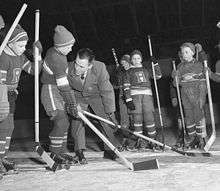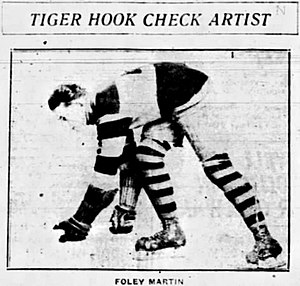Checking (ice hockey)
Checking in ice hockey is any of a number of defensive techniques aimed at disrupting an opponent with possession of the puck or separating them from the puck entirely. Most types are not subject to penalty.
Types

- Body checking
- A player drives the shoulder, upper arm and hip and elbow, equally into the opponent to separate them from the puck, using the body to knock an opponent against the boards or to the ice. This is often referred to as simply checking or hitting and is only permitted against an opponent with possession of the puck. Body checking can be penalized when performed recklessly. It is considered an "illegal hit" in IIHF women's hockey and is punishable by a minor penalty, major penalty and automatic game misconduct, or match penalty.[1]
- Hip-checking
- When a player drops to a near-crouching stance and swings his hips toward an opposing player, sending the opponent off balance, often falling to the ice. Mostly done up against the boards. A hit at or below the knees is considered an infraction in the National Hockey League, and called "clipping".
- Shoulder-checking
- A player puts his shoulder into his opponent to muscle the opponent out of position. The elbow must be tucked in, or the player risks taking a penalty for elbowing.
- Poke checking
- Using the stick to poke the puck away from an opponent. Mostly done while the defensive player goes straight at the puck carrier and hitting the puck out of his possession before making physical contact.

- Hook checking
- Using the stick in a hooking manner on the ice surface to retrieve the puck from opponent players.
- Sweep checking
- Using the stick in a sweeping motion to knock the puck away from opponents or deter them from passing.
- Stick checking
- Using the stick to interfere with an opponent's stick.
- Forechecking
- It refers to skating done in the offensive zone, often to recover possession of the puck after a dump in or turnover.
- Backchecking
- Rushing back to the defensive zone in response to an opposing team's attack. Players often try to 'rub up' behind the player with the puck to bother them. At the same time they try to hit the puck away with their stick.
- Cross-checking
- The act of checking an opponent with the shaft of the stick held in both hands and with arms extended. This is illegal and earns a minor or major penalty depending on the severity of the infraction.
- Lift checking
- A player lifts or knocks an opponent's stick upwards with his/her stick followed immediately by an attempt to steal the puck. This may also be used by a defenseman to keep an opposing player from deflecting shots when both players are positioned in front of the net.
- Press checking
- A type of hockey stick check used to stop or control the movement of an opponent's stick by placing stick pressure over the top of the opponent's stick.
Rules on checking
Illegal checking
Charging, hitting from behind and boarding are examples of illegal hits. Charging occurs when a player takes three or more strides going into the check, and sometimes includes leaving the feet to deliver the hit. Boarding is when a check violently throws a defenseless player into the boards.[2] Due to their dangerous nature and increased likelihood of causing serious injury, these hits can have penalties ranging from a minor two-minute penalty to a major and game misconduct, along with a $100 fine in the NHL.[2] In women's ice hockey, any body checking is a penalty and is also not allowed in leagues with young children. Men's amateur leagues typically allow checking unless stipulated otherwise in league rules. Some intramural university leagues do not permit body checking, in order to avoid injury and incidents of fighting. "Leaning" against opponents is an alternative to body checking but can be penalized for holding if abused. Many studies have been done regarding injuries in hockey that have caused stricter rule enforcement in the 2010s.[3][4] There have been decreases in the number of concussions and other serious injuries since these changes.
Beginning with the 2010–11 NHL season, any form of "lateral or blind side hit to an opponent, where the player's head is targeted and/or the principal point of contact" (which is known as an illegal check to the head) became prohibited. That season, an illegal check to the head is punishable with either a major penalty and game misconduct or a match penalty.[5] This new rule was instituted as a result of concussion injuries to NHL players in previous seasons. In the 2011–12 NHL season, any hit to an opponent, where the player's head is targeted and the principal point of contact" (which is known as an illegal check to the head) became prohibited. An illegal check to the head is punishable with either a two-minute minor penalty or a match penalty. In the 2013–14 NHL season, the rule was clarified to a hit resulting in contact with an opponent's head where the head was the main point of contact and such contact to the head was avoidable is not permitted (which is known as an illegal check to the head) became prohibited. An illegal check to the head is punishable with either a two-minute minor penalty or a match penalty.Rule 48 – Illegal Check to the Head
New NHL standard of rule enforcement, 2005–06
For the 2005–06 season, the NHL instituted stricter enforcement of many checking violations that in previous seasons would not have been penalized. The intent of the new standard of enforcement was to fundamentally alter the way ice hockey is played, rewarding speed and agility over brute strength, as well as increasing opportunities for scoring and minimizing stoppage of play. However, it is unclear how expanding the definition of a penalty would minimize the stoppage of play, as penalty calls entail play stoppage. One explanation may be that more clearly defined rules give players more distinct boundaries on penalties, resulting in fewer penalties. The intended result is a faster-paced game with generally higher scores than in previous years.[6]
New USA Hockey rules on checking, 2011–12
Beginning in the 2011–12 season, USA Hockey moved the age of legal body checking from 12U to 14U.[7] The discussion of this rule change began with a look into Peewee (12U) and Squirt (10U) levels of hockey. Through observation, it was clear that Squirts skate more aggressively and try to play in the correct manner. Peewees in similar situations would either let the opponent get the puck first so they can check them or hold back so they don't get hit themselves. Injury wasn't an initial concern but with research it was brought into the discussion. Research shows that the 11-year-old brain has not developed skills to anticipate. As a result, Peewees acquire injuries four times more in checking vs. non-checking hockey.[8]
References
- "Rule 169 – Illegal Hit (Women)" (PDF). IIHF Official Rule Book 2014–2018. International Ice Hockey Federation. p. 96. Retrieved April 8, 2018.
- "Rule 41 - Boarding". National Hockey League. Retrieved 1 August 2014.
- Lorentzon, MD, PhD, Ronny; Wedrèn, MD, Hans; Pietilä, RPT, Tom (1988). "Incidence, nature, and causes of ice hockey injuries A three-year prospective study of a Swedish elite ice hockey team". The American Journal of Sports Medicine. 16 (4): 392–6. doi:10.1177/036354658801600415. PMID 3189665.CS1 maint: multiple names: authors list (link)
- Flik, MD, Kyle; Lyman, PhD, Stephen; Marx, MD, MSc, FRCSC, Robert (2005). "American Collegiate Men's Ice Hockey: An Analysis of Injuries". The American Journal of Sports Medicine. 33 (2): 183–7. doi:10.1177/0363546504267349. PMID 15701603.CS1 maint: multiple names: authors list (link)
- Rule 48 – Illegal Check to the Head, Official Rules, NHL.com
- [NHL] Rules Changes: Probing The Brave New Hockey World
- [USA Hockey] Body Checking Rule, archived from the original on January 3, 2012
- [USA Hockey] Body Checking Rule Change Proposal